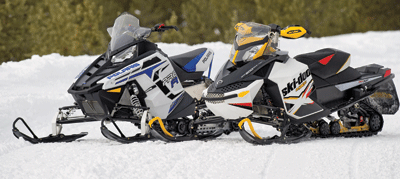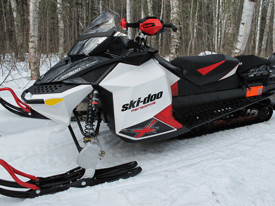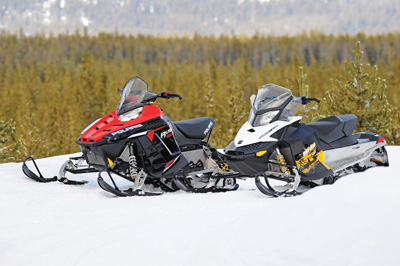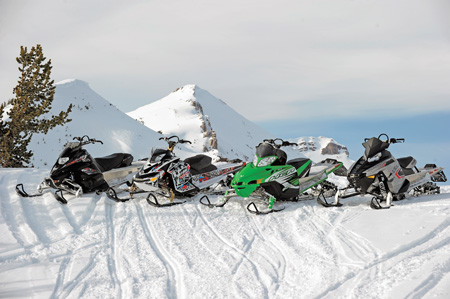 With so many major changes made to snowmobiles in the two-stroke ultimate performance class for 2011, this story was immediately filed under the “Must Do” category when we planned for our annul Rode Reports test event, this time in West Yellowstone, Montana.
With so many major changes made to snowmobiles in the two-stroke ultimate performance class for 2011, this story was immediately filed under the “Must Do” category when we planned for our annul Rode Reports test event, this time in West Yellowstone, Montana.
Polaris had a new snowmobile in the 800 Rush Pro-R and Ski-Doo returned with its MX Z X-RS, now with E-TEC direct injection feeding the powerful 800R engine. Last year, Arctic Cat revived its F8 Sno Pro with a new engine that puts out 10 hp more than the 800 Suzuki it replaced, plus it gained new skis and shocks.
With the wide variety of mountainous trails, world-class suspensions and more horsepower on tap than a Texas rodeo, we knew this ride was going to be riotous fun. We ordered an MX Z X for this comparison story because it most closely aligns with the packages from Polaris and Arctic Cat, but Ski-Doo didn’t have that machine available for our test ride. Our next option was the X-RS.
How Well Do They Fit?
You might think comfort isn’t an important attribute of sleds in the ultimate performance class. After all, the people who buy these snowmobiles are “hard riders” who care more about going fast and pounding the bumps than making sure the seat, handlebars and footwells are manufactured at just the right durometer, curve or angle. This might be true to some extent, but discomfort on a snowmobile throws the driver’s concentration and makes it difficult to control the machine, not to mention causes fatigue.

The F8 Sno Pro is certainly in its own class, focusing more on rider comfort than performance. It’s a bigger, heavier machine than the Ski-Doo or Polaris. That added weight and size makes it the most stable while cruising down the trail and contributes to the Cat’s higher level of trail comfort over the other two sleds.
The Infinite Rider Positioning (IRP) system provides adjustability of the seat and handlebars, so our test riders — ranging from 5 feet, 9 inches to 6 feet tall — were able to set these two body-to-sled contact points for optimum comfort and control. The Cat’s handlebars are wide to provide a lot of leverage and control, but the end of the bar is a long reach for the outside hand on sharp turns.
The wide, slippery seat is plush and supportive, but that gets in the way of quick side-to-side movements — even for riders with longer-than-average inseams. One tall rider said he felt half-on/half-off the seat through turns where he leaned hard into the corner. Not being able to get as low as he could on the Polaris or Ski-Doo isn’t a handling defect, he said, but it lends the perception that cornering speeds are slower.
On the opposite end of the ergonomic spectrum sits the Ski-Doo MX Z X-RS. It truly is a race sled with raw, edgy appointments that prove — through appearance and function — this sled is meant for fast, high-performance trail riding.
The stripped off handlebar is the same perch that’s used on Ski-Doo’s MX Zx 600 RS race sled, utilizing the pipe preheat button (it’s actually zip-tied to the handlebar!) as the electronic reverse control switch. The aluminum throttle block looks rugged and the 5-inch riser block promotes stand-up riding (but prevents a clear view of the gauge pod unless you are, in fact, standing up).
This sled handles moguls at high speeds very well, due partly because of its ergonomic package that makes a driver feel confident in self and machine. Why does it exude confidence? Because the forward-mounted steering post, seat height, bar angle and driver position sets the pilot in an attack position.
When seated, drivers noticed the seat is sticky — on the verge of being too grippy to quickly slide across. As the covering wears will it improve or get worse? Air temperature was about 45 degrees F during our testing; maybe the material is more slippery when it’s cold. The firm foam kept the rider’s posture up for easy transitions and provided a good view of what lay ahead. One tester didn’t like the seat shape, saying it felt like there was a basketball under his keister.

Opinions of the Rush’s ergonomics seemed dependant on each driver’s height, with tall drivers being more in favor of how well the sled fit. Our tallest rider had nothing but good things to say about the Polaris’ ergos. He enjoyed how well his body influenced the machine’s behavior. Seat position, leverage, lean and stance all influence what this thing does and how well it does it, he said.
Moving down on the growth chart to our 5-foot, 10-inch rider, he felt limited knee room and the seat seemed to push him into the side panels. The runt of the group said the console feels too wide, which made the whole sled feel big. The seat was too squishy, keeping him out of a ready position.
The Rush’s steering system has a comfortable range of motion; meaning there’s a good balance of how far the driver’s hands move up/down and forward/back through turns. This keeps the bar ends within reach and out of the driver’s chest.
The hooked handlebars, their height and setting within the clamps felt good and solid. Roomy footwells accommodate the big snowboard-style boots that are common while not being so large that the driver’s feet bounce in rough conditions. Serrations on the running boards also help keep the feet stationary.
Powering Through It All
You can’t go wrong with any of the three engines in this shootout. Each powerplant rips down low, through the mid-range and up to the top end, but they all have a different feel and sound. It boils down to what kind of power your thumb craves. Trails where we rode these sleds were mostly smooth and set-up with moist spring snow, so we developed a good feel for their power delivery out of corners and for how well they run at high speeds. It was a fun test.
Though it’s been through some revisions, we’ve gotten familiar with the Polaris 800 CFI engine — now in its fourth year. Like all Liberty engines, this is a torque-laden mill with power the driver can feel in his or her gut when squeezing the throttle no matter where the engine is in the power band. It pulls hard with consistent, linear acceleration. During a strong squeeze of the throttle lever it gives a sharp bark from the exhaust pipe that’s pleasing to the ear. And when pulling the trigger, power comes on smoothly so it’s easy to use in the tight woods or rough trails, while still having a stout “snap” to lighten the skis over a hole or mogul. The 800 Liberty CFI puts out roughly 145 hp.
What isn’t there to like about the 800 CFI? Fuel mileage. We recorded 10.545 mpg on this test ride. Polaris has become the fuel-economy goat over the years, and the brand needs to make real strides toward increased efficiency. We expect direct injection to come out of the Roseau, Minnesota, factory soon (perhaps as soon as 2012), so there’s hope for big gains in the near future.

The engine in the MX Z X-RS we rode for this test had a problem with its 3-D R.A.V.E. system, but one of our Ski-Doo demo sleds last winter was an MX Z with the E-TEC 800R engine. Engine impressions here are based on that sled’s performance.
It’s remarkable what a difference direct injection makes in terms of power delivery from the 800R engine in the Ski-Doo. In years past we proclaimed the Polaris engine as the smoothest 800 of the pair, but with E-TEC hardware fastened to the Rotax cylinder head, it now takes the cake for its buttery performance. Don’t let that civilized delivery fool you, though, because this engine is powerful, making the E-TEC 800R the most sneaky-fast two-stroke on snow.
Everything sounds and feels spot-on with the E-TEC 800R engine. It’s crisp, clean and powerful. Power comes on forcefully, but it’s comfortable and controlled because it doesn’t spool up and then suddenly uncork and launch the sled into next winter like a less-refined two-stroke might do. Ski-Doo rates the Rotax E-TEC 800R at 155 hp.
The sled accelerates with authority, but does so in a civilized manner. Crack the throttle at the apex of a turn and it quietly and precisely launches out of the corner and nudges the driver toward the rear of the seat. A firm squeeze of the throttle lever while rolling along at 30 or 40 mph will bring you to 75 mph quicker than you can say “Oh, Canada!”
The Suzuki H.O. 800 is the most playful two-stroke to come out of Thief River Falls in a long time. It’s lively and responsive on the bottom end so Cat riders can now play with bumps and road approaches, too. Instead of hearing the bog that’s common with earlier laydown Suzukis, riders feel torque, acceleration and weight transfer.
Testers noted that the F8 Sno Pro ran cleaner than expected without the sluggish, rich behavior we’ve experienced before. Not only did the fuel map seem dialed-in, but the design of the new H.O. 800’s cylinders, crankcase and head must be making better use of the air/fuel charge. Cat claims the engine puts out 160 hp.
This Suzuki has real throttle response you can feel, and it runs strong, a result of a better design and improved fuel and clutch calibrations. But there’s more of a raw feel because it has a firmer hit and it pulls more abruptly than the Polaris and Ski-Doo, which makes it feel faster than those sleds.
Its exhaust note isn’t as “well-done” though, which contributes to its uncooked personality. An engine that performs this well should sound better and make you proud to hear it. Put simply, the exhaust system sounds cheap and ragged; it doesn’t have the full and rich exhaust note that Ski-Doo and Polaris owners enjoy. Instead, Cat riders hear a pipe that sounds ratted out.
Hitting Bumps, Twists And Turns
If you’ve read to this point, you know that all three sleds have power to satisfy the appetite of any snowmobiler, but if a chassis and suspension can’t handle the speed, what good does all of that horsepower do? Fortunately these sleds use their power very well, thank you.
The Polaris Pro-Ride chassis feels rigid and solid so the driver can feel everything the machine does. Without question, the rear is better in the chop than last year’s version in the 600 Rush. Now we can power over trail ripples rather than have our teeth rattle and heads bobble. Thankfully the skidframe is still playful. Polaris engineers say the improved ride is due to a new rail profile and front torque arm. Another benefit Polaris claims is reduced rolling resistance for more speed and less noise.
Predictability has also improved over the 2010 version, which has been a strong attribute of the IQ chassis; fortunately there’s more of it in the Rush this year. Both ends of the sled set down softly after jumping off of rollers and moguls.
Steering is good and flat as long as you’re an active driver, but sitting and just driving without aggressive leans makes the handling fidgety with lots of lift and line corrections mid-corner. Two test riders noted major feedback through the handlebars in rough moguls, which makes a driver busy keeping the skis pointed in the right direction. Handling on smooth trails has a nice balance between sticking to the line and slipping a little bit to relieve effort from the driver. The skis make the front end predictable, with reliable traction and appropriate steering effort for a Rush Pro-R rider.
Walker Evans Needle shocks have a wide range of adjustment with noticeable differences in performance within just a few clicks. One tester crashed through the front suspension while running a section of big moguls, but three clicks to increase compression resistance dialed them in. The front suspension felt too springy at three clicks from full soft for another tester, but one more click toward “hard” tightened up the feel.
The rear spring is sensitive to adjustment, too, and finding the right setting is key to make a Rush perform well. Case in point: One tester had the spring set 4 pounds stiffer than his weight, but after adjusting the spring to his actual weight he felt more transfer, lighter steering and less darting while maintaining good traction on the skis. The spring is difficult to adjust, so we’re hoping Polaris finds a way to make this easier. The front track shock clicker is nearly impossible to turn because of its orientation inside the skidframe, so this needs work, too.
We say this every year, but it’s true: The Twin Spar chassis keeps getting better as minor updates result in major improvements. This time the boosted performance is courtesy of the Fox FLOAT 2 shocks and new skis that were added in 2010.
Valving proved to be good for a wide range of needs, whether that’s low-speed cruising or blazing over chop at high speeds. Calibration allows for flat cornering and they set down nicely after the front end goes airborne over rollers.
On the trail, the F8 Sno Pro handles well but it drives larger and heavier than the MX Z or Rush. Testers really like this sled now that the Twin Spar steers lightly and positively without corner push, and the powerful new engine makes the chassis feel even lighter.
The F8 definitely isolates from the bumps better than its competition. It’s a nice ride and comfortable but not as playful — you can’t work with the bumps. Instead of timing the moguls and pre-loading the skidframe to launch, the driver can simply remain steady with the throttle and mow them over. Two riders noted a lot of bottoming on the front arm through the moguls, but the lightest tester said it worked better than expected.
Does the F8’s longer wheelbase (128-inch track versus 120 inches on the MX Z and Rush) put more load on the front torque arm? Perhaps. The bump energy is noticed, but with a firm calibration on the damper, it does well to absorb the impact. The sled handled curves in the trail really well, it’s the best of the three sleds. Also noted: lean out — not forward — during high-speed turns to get the best handling.
The MX Z X-RS works in the bumps. It kept asking for more when we tested it in rough conditions while the front and rear suspension worked in synch through the moguls we crashed it into. The whole sled felt light, controlled and easy to drive, and it forgives the driver’s errors quite graciously.
In the big-bump section of our test, the X-RS was light and nimble and it had the best suspension sweet spot for rough trails. The sled’s lightweight design, though, made it feel less stable than the Polaris or Cat.
While adjustments proved necessary to get the best performance from the Polaris, the yellow sled’s stock shock and spring settings worked surprisingly well over a variety of conditions for all test riders. Low-speed valving on all four dampers is more compliant than the 2010 version we tested a year earlier.
In smoother conditions, the REV-XP chassis still displays some Ski-Doo twitchiness when diving hard into a corner. Here the driver has to reset the skis and counter the chassis’ tendency to understeer through turns. The original REV was notorious for this, especially in rough corners. While the XP chassis is much improved over its predecessor, the X-RS platform with the steering post mounted 2 inches farther forward magnifies this characteristic. Like the Rush, it translates to a lot activity at the handlebar during aggressive rides.
The X-RS is definitely a more aggressive setup than 97 percent of riders need. Sure, the suspension is adjustable, but most snowmobilers don’t take the time to understand their shocks so they can make the correct adjustments. And with so many external adjustments on the KYB Pro 40 dampers — high/low speed compression and rebound up front; high/low speed compression in the rear — some riders could be intimidated by all of the adjustability and afraid to make the changes they might need.
Three Distinct Choices
While these three snowmobiles are in the same class, they have distinct personalities. The MX Z X-RS and Rush Pro-R are most alike, appealing to hard-core sledders who ride aggressively. Similarly, the F8 Sno Pro is for snowmobilers who ride fast, but expect more comfort for longer days in the saddle.
It took Arctic Cat a few years to get the Twin Spar-based F Series machines to work as well as they do now. Vague handling plagued early versions and, admittedly, our expectations in 2007 when the F Series debuted were for it to mimic the lightweight, point-and-shoot characteristics of the Firecats they replaced. But now we know the F Series is a platform that, while it goes fast and rides and handles well, was designed more for comfort and stability than hammering down a ditch or slicing through the woods.
One year has made a big difference in the performance of the Polaris Rush. The initial 2010 Pro Ride chassis was a bold step away from tradition, especially for a company as conservative as Polaris; we just wish its performance could have been at the level where the Pro-R is now. It’s a tight-feeling machine that rides and handles well with more power than the original Rush.
We’ve always thought that snowmobiles like Ski-Doo’s MX Z E-TEC 800R X-RS are about feeding a rider’s ego, but this sled is the most trailable wannabe racer we’ve ever ridden. Engine power and the machine’s responsiveness mated with the suspension’s out-of-this-world capability give a snowmobiling experience that’s truly like no other, but before you plunk down $13k for the X-RS, ask yourself, “Do I really need this much sled?” Chances are that the MX Z X will meet your needs just fine, and cost $1,000 less.




